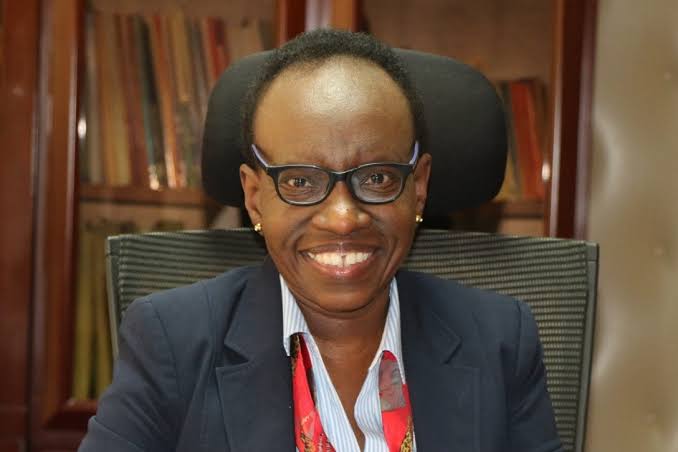CBC Curriculum Likely To End. Auditor General Nancy Gathungu claims that there is no way to justify the astounding Sh3.99 billion that was set aside for the construction of Competency Based Curriculum (CBC) classrooms.
In her most recent report for the 2022–2023 Financial Year, the Auditor highlights several irregularities in the classroom construction process, including worries about subpar workmanship and pricing.
Gathungu raises more concerns about the Sh1.6 billion in scholarship spending made by the State Department of Basic Education.
The report also reveals that up to 7,340 children in Grade Seven did not receive any capitation totaling Sh110.1 million due to inadequate data.
In order to support its 100% transition policy to secondary schools, the national government declared in 2022 that it planned to build 10,000 CBC classrooms under the schools infrastructure construction program.
The cost of the thousands of classrooms built under the initiative is questioned in the report.
In particular, it begs the question of how the State Department determined that the national average cost of a single classroom is Sh709,398 when bills of quantities and market survey findings were not made available for examination.
It also says that there was no way to have a uniform rate because of the uneven topography and terrain of the schools around the nation.
CBC Curriculum Likely To End
“How the different suppliers were found and the precise procurement procedure that was employed were not explained by management. Likewise, there was no proof that the pricing had been updated to account for inflation and represent the going rates for purchasing building supplies on the open market. The regular allocation of Sh709,398 was insufficient to build a classroom of the necessary caliber, according to the study.
“The value for money for the construction of CBC classrooms amounting to Sh3,997,687,865 could not be confirmed under the circumstances,” it continues.
The report also casts doubt on the caliber of the classroom construction, pointing out that physical inspection of 215 secondary schools across 27 counties indicated that the buildings were built in less than two weeks, which was insufficient time for the concrete to cure. It also added that the concrete’s potential strength and durability had not yet reached its full potential.
According to the assessment, the short construction period and inadequate funds led to the subpar construction of the classrooms.
“The sampled schools had badly built classrooms with floor fractures and deep gaps at the time of the audit. In certain classrooms, the floor had entirely collapsed, revealing the earth underneath. Students were thus forced to learn in dusty classrooms, putting their health at risk, according to the report.
The report also reveals that the majority of the sampled schools’ current classrooms had terrazzo or tiles on the floor and a ceiling. Physical inspection showed that the administration of a few sampled schools had used their own funds to guarantee that new classrooms were built to the same standards as the ones that already existed
CBC Curriculum Likely To End
Furthermore, the audit found that, as of the audit’s period, 30 of the 215 sampled classrooms were not in use. According to management interviews, there were enough classrooms at the schools for the number of students enrolled. The study states that in several cases, the classrooms had been turned into storefronts.
Regarding capitation, the report expresses sadness that students in Junior Secondary Schools (JSS) were not able to collect the full Sh110.1 million in capitation since precise student counts were not disclosed.
According to the report, the inconsistency can be attributed to the State Department of Early Learning and Basic Education, which failed to ensure that the data utilized for JSS capitation was validated by the relevant sub-county offices prior to funding disbursement.
According to the study, the sub-county offices would have made sure that every student is registered for funding through a single National Education Management and Information System (Nemis).
Nonetheless, pupils at 187 of the 312 junior secondary schools in the sample did not get capitation. 29,653 students were enrolled in the 187 JSSs in reality. However, the report states that 7,340 students were not funded because 22,313 students got capitation.
The report expresses concern with Nemis’s configuration, which lacks a cutoff and continuously updates pupils, so making it challenging to verify the exact number of students at a given time.
It was also regrettable that there was a high student-teacher ratio and a detrimental impact on teacher-student engagement in Grade Seven classes due to overcrowding, with some classes having as many as 80–100 students, much over the required 45.
Likewise, there were no science labs in the schools. It was also observed that students over the age of 18 are neither funded by the system, nor can they be registered without birth certificates.
According to the report, there were a number of irregularities in the scholarship allocation process that resulted in the disbursement of Sh1.6 billion. These irregularities include unsubstantiated student transport costs, unequal scholarship allocations, a failure to identify and declare assets, and poor value for money when it came to consulting services.
According to the report on unsupported transport payments to students, each term each student is expected to travel four times, including on opening day, midterm (to and from), and closing day. However, upon reviewing the provided expenditure schedules, it was found that the transport payments to twelve sampled students for five terms—three in 2022 and two in 2023—appeared inflated, with the cost of each trip ranging from Sh4,755 to Sh7,715.
CBC Curriculum Likely To End
According to the Equity Group Foundation’s (EGF) inception report, dated November 15, 2022, the fund offers transportation funds to its beneficiaries at a standard rate determined by the distances the students travel from their homes to the closest Equity Bank branch and to their schools on term opening, midterm, and closing days.
Every student makes four trips during a term: the opening day, the midterm (to and from), and the ending day.
